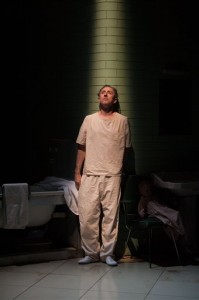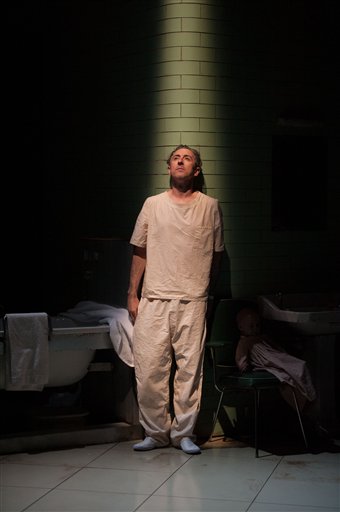
NEW YORK — In these days where celebrity divorce is in the headlines, you’ve gotta tip your hat to the enduring and iconic marriage of Macbeth and his Lady. He’s got the ambition, she’s got the boundless nerve, and together, they can achieve the unthinkable.
But wait — what if they were simply two parts of the same person? That’s the head-spinning — or should we say, head-splintering — question raised by the newest “Macbeth” to hit New York, with the charismatic Scotsman Alan Cumming as both Mr. and Mrs. McB.
But the production, which comes from the National Theatre of Scotland via the Lincoln Center Festival, doesn’t stop there. Cumming also plays Macduff, and King Duncan, and Banquo… oh, and the three witches, too. He plays all the main characters, and they’re all parts of a shattered personality, belonging to an unnamed man who’s committed an unnamed crime and is now in a mental ward.
Yes, it’s a very cool concept, and one that sounds well-nigh irresistible when combined with the undeniable talents of Cumming, a Tony winner for 1998’s “Cabaret,” and his directors — John Tiffany, fresh off a Tony win for the musical “Once,” and Andrew Goldberg.
But while the production is handled with great skill and has plenty of riveting moments, the concept often seems to limit rather than enhance both the accessibility and the sheer drama of this famous Shakespearean play.
The biggest challenge are the transitions from character to character — as absorbing as Cumming is to watch, and even though the play has been trimmed significantly, following these transitions demands a lot of focus and concentration from the audience.
And if you’re not very familiar with the play, you’ll likely get hopelessly lost trying to figure out who is who, since the character shifts are inevitably subtler than usual, with no costume changes, set changes or indeed personnel changes to announce them. Theatergoers be advised: It’s essential to brush up on that Shakespeare before attending.
The stage at the Rose Theater, normally home to Jazz at Lincoln Center, has been transformed into a cold and antiseptic hospital ward. In a silent beginning, Cumming’s mental patient arrives and is processed by two attendants who remove his clothes and take swabs of DNA.
Kudos to set designer Merle Hensel: This ward is a spooky place indeed, all tiled and sickly green, with only a cot, a bathtub, a sink and mirror, a big chair and a table to spruce up the place. There’s a window high above the patient, through which his keepers monitor him — and a closed-circuit TV system with three large screens that show his rantings.
Those screens are especially effective when Cumming plays the three witches. Also effective is the way he uses a mere towel, after one bathtub moment (yes, the bathtub is filled, and Cumming gets wet more than once) to differentiate between Macbeth and Lady Macbeth.
A mirror is a clever device to reflect a conversation between characters. Other useful props include a small boy’s sweater, to indicate the ill-fated son of Macduff, and a black raven that comes to a pretty disgusting end. A doll is used as a stand-in for Malcom, Duncan’s son; it even gets a little curtain call at the end, aided by Cumming.
Myra McFadyen and Ali Craig, as the attendants, speak only late in the play, and their contribution, especially when setting up Lady Macbeth’s “Out, damned spot!” speech, is welcome.
Music by Max Richter, sound by Fergus O’Hare, and lighting by Natasha Chivers all add to the sinister nature of the proceedings. But the production’s best asset is Cumming, who is even called on, during what one could call an intense marital discussion, to have sex with himself.
Cumming has said that an initial idea for the production, later jettisoned, was to have him play Macbeth and Lady Macbeth in alternate performances, switching off with an actress. That would also have been interesting, and perhaps a way to explore this terrific actor’s versatility while mining a bit more of the inherent drama in the play. In the end, due to its creative but challenging guiding concept, this “Macbeth” is more chilling and spooky than tragic or terrifying.












































